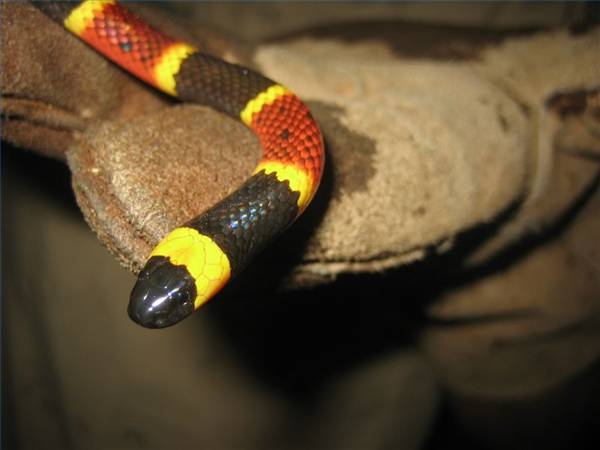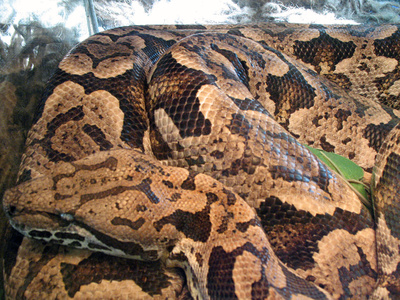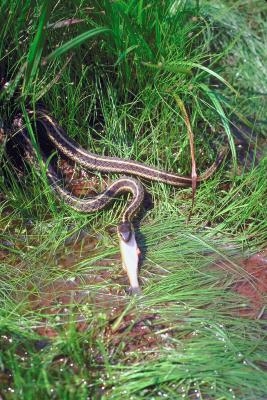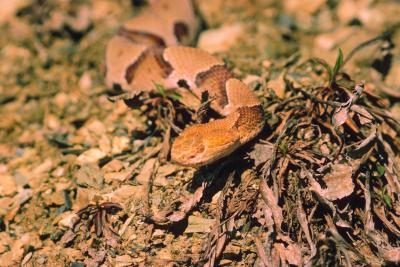
Identifying a Venomous Snake. When hiking or spending time outdoors, it is always important to be aware of snakes. A run-in with a poisonous snake can be painful and can even kill you. It is important to understand what markings and behaviors usually signify that a snake is poisonous. Regardless of whether you feel the snake is poisonous or not, you should not handle or disturb a snake in its natural habitat.

When hiking or spending time outdoors, it is always important to be aware of snakes. A run-in with a poisonous snake can be painful and can even kill you. It is important to understand what markings and behaviors usually signify that a snake is poisonous. Regardless of whether you feel the snake is poisonous or not, you should not handle or disturb a snake in its natural habitat.
Since most snakes would rather warn off predators than fight them, many poisonous snakes will have a multitude of bright colors to warn predators that they are poisonous. Many poisonous snakes will have even more than one bright color on their bodies. The most common poisonous snake in the United States that can be identified by its colors is the eastern coral snake. This snake has bright yellow and red stripes mixed with black bands. Most other color-bearing poisonous snakes are found in the tropical regions of South America, Africa and Asia.
You can also tell many venomous snakes by looking at their heads. If the snake is venomous, it will be more likely to have a flat head. A non-venomous snake will have a more rounded, spoon-shaped head, though this is not always the case.
If the snake you are looking at is shaking its tail and the tail is making a rattling sound, you may be dealing with a venomous snake--the rattlesnake. However, some young rattlesnakes may not have a completely formed rattle and may shake their tail without any sound. Some non-poisonous snakes also fake the shaking of the tail like a rattler, but are actually harmless. If you hear a rattle or see a snake shaking its tail, stay away.
Venomous snakes use a heat sensor called a pit to sense their prey. This is a small impression on the snake's face between the nostril and the eye. Once again, some non-venomous snakes may also have a pit, but they are more common in venomous ones.
Water moccasins are common in water-fed areas such as Florida and other parts of the Southeastern U.S., although water moccasins may also be found in the west. It is hard to tell the difference between the many harmless water snakes and the extremely venomous water moccasin. In most cases, non-venomous water snakes will float with only their head above the water, while the water moccasin will float with part of its body out of the water as well. In any case, water snakes should be left alone. The water moccasin is very defensive, and will even approach you if you are leaving it alone if it senses you. You should get out of the water immediately if you see a water snake in your area.
 Snake Catching Tools
Snake Catching Tools
Snake Catching To
Snake Catching Tools
Snake Catching Tools
Snake Catching To
 How to Know If a Ball Python Is a Boy or Girl
How to Know If a Ball Python Is a Boy or Girl
How to Know If a Ball Python Is a Boy or Girl
How to Know If a Ball Python Is a Boy or Girl
 Types of Garter Snakes
Types of Garter Snakes
Types of Garter
Types of Garter Snakes
Types of Garter Snakes
Types of Garter
 Snakes Common to Houston
Snakes Common to Houston
Snakes Common
Snakes Common to Houston
Snakes Common to Houston
Snakes Common
 Identifying a Venomous Snake
Identifying a Venomous Snake
Identifyi
Identifying a Venomous Snake
Identifying a Venomous Snake
Identifyi
Copyright © 2005-2016 Pet Information All Rights Reserved
Contact us: www162date@outlook.com